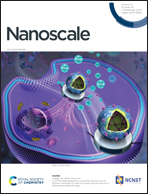Construction of mPt/ICG-αA nanoparticles with enhanced phototherapeutic activities for multidrug-resistant bacterial eradication and wound healing†
Abstract
The emergence of multidrug-resistant (MDR) bacterial infections calls for novel strategies for effective bacterial inhibition and wound healing. Phototherapeutic approaches are promising in treating bacterial infection because of their high efficiency, noninvasiveness, and few side effects; however, their antibacterial effect is limited by the formation of biofilms in wounds. Herein, we report novel composite nanoparticles (mPt/ICG-αA NPs) combining mesoporous platinum (mPt) nanoparticles, indocyanine green (ICG) and α-amylase (αA) for combating MDR bacteria and treating wound infection, which integrates a triple bacterial inhibition mechanism arising from the combination of photodynamic therapy (PDT), photothermal therapy (PTT) and α-amylase enzymatic activities. The combination of mPt and ICG significantly enhances the effect of PTT and the temperature can be increased up to 80.8 °C to induce efficacious bacterial degeneration. Meanwhile, mPt/ICG-αA (mPIA) NPs with a low concentration of 25 μg mL−1 exhibited a remarkable catalase activity (CAT) and could continuously decompose endogenous H2O2 into O2 in a hypoxic microenvironment, thereby enhancing the PDT effect to achieve broad-spectrum bactericidal activity. mPIA NPs showed excellent MDR antibacterial efficiency against both Gram-positive Staphylococcus aureus (S. aureus) and Gram-negative Escherichia coli (E. coli), and the bactericidal rate reached up to 99.0% and 97.2% with single 808 nm near-infrared light irradiation, respectively. mPIA NPs also exhibited an excellent ability to destroy biofilms and biocompatibility. Animal experiments further suggested that mPIA NPs could achieve the successful repairment of wounds infected with S. aureus in living systems, while this platform demonstrated negligible toxicity towards mice. Considering the superior performances of mPIA NPs, the synergistic αA-CAT-PDT-PTT boosted therapeutic activity presented in the current work provides a promising method to effectively fight against biofilm-related infectious diseases and wound healing.

- This article is part of the themed collection: Nanozymes


 Please wait while we load your content...
Please wait while we load your content...